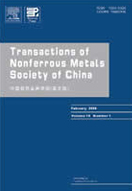Effect of compositional homogenization on hot workability of Ni-based GH4061 superalloy
(2. Department of High-temperature Materials, Central Iron and Steel Research Institute, Beijing 100081, China;
3. Key Lab for Anisotropy and Texture of Materials, Ministry of Education, Northeastern University, Shenyang 110819, China;
4. Sino-French Institute of Nuclear Engineering and Technology, Sun Yat-Sen University, Zhuhai 519080, China)
3. Key Lab for Anisotropy and Texture of Materials, Ministry of Education, Northeastern University, Shenyang 110819, China;
4. Sino-French Institute of Nuclear Engineering and Technology, Sun Yat-Sen University, Zhuhai 519080, China)
Abstract: Complex solidification process, severe chemical segregation and large amounts of secondary phases with low melting point between dendrites deteriorate the hot workability of as-cast GH4061 superalloy. The effects of the homogenization temperature and time on the dendritic segregation, dissolution behavior of Laves phase with low melting point intermetallic phases and hot workability of the alloy were investigated using OM, SEM, EPMA and TEM. The results show that in the as-cast sample, severe compositional segregation is found among dendritic structures and the highest segregation coefficient of Nb is 2.435, followed by Ti of 1.346 and Mo of 1.200. After homogenization at 1160 °C for 20 h, the segregation among dendritic structures has been fully eliminated and the segregation coefficient of Nb declines to 1.098. Meanwhile, Laves and d phases are mostly dissolved and no any localized grain boundary re-melting was observed. Increasing annealing temperature accelerates the speed of chemical homogenization and dissolution of intermetallic compounds. High-temperature mechanical properties testing results demonstrate that two-step homogenization treatment promotes the plasticity up to 1150 ℃. Fracture analysis reveals that the dissolution of Laves and d phases reduces the probability of crack initiation and fracture, resulting in a good hot workability.
Key words: GH4061 superalloy; dendritic segregation; Laves phase; hot workability

